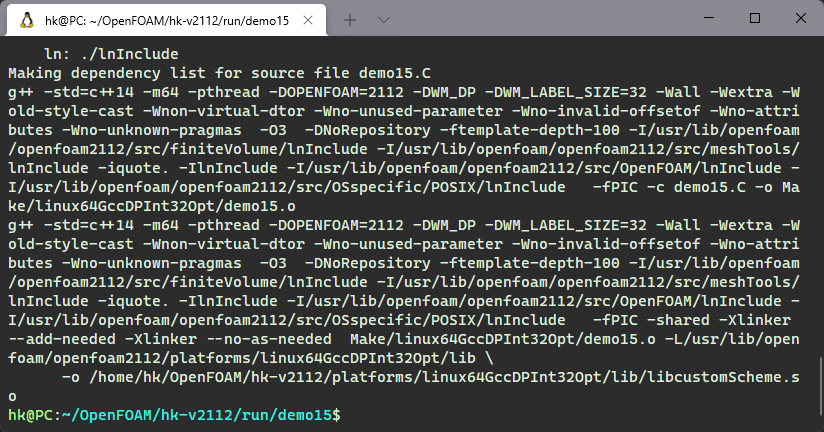本案例演示利用OpenFOAM创建自定义插值格式。
1 文件结构
利用下面的命令创建文件结构:
run
foamNewApp demo15
cd demo15
touch demo15.H
文件结构如下图所示。

-
修改 Make/files文件
demo15.C
LIB = $(FOAM_USER_LIBBIN)/libcustomScheme
-
修改 Make/options文件
EXE_INC =
-I$(LIB_SRC)/finiteVolume/lnInclude
-I$(LIB_SRC)/meshTools/lnInclude
EXE_LIBS =
-lOpenFOAM
-lfiniteVolume
-lmeshTools
2 程序代码
-
头文件 demo15.H
#ifndef demo15_H
#define demo15_H
#include "surfaceInterpolationScheme.H"
#include "volFields.H"
namespace Foam
{
// 创建一个继承自surfaceInterpolationScheme的模板类
template <typename T>
class customScheme : public surfaceInterpolationScheme
{
const surfaceScalarField &faceFlux_;
public:
// 运行时类的信息
TypeName("customScheme");
//----------------构造函数-----------------------------------------
// 从面通量进行初始化
customScheme(const fvMesh &mesh, const surfaceScalarField &faceFlux):
surfaceInterpolationScheme(mesh),
faceFlux_(faceFlux)
{
}
customScheme(const fvMesh &mesh, Istream &is) :
surfaceInterpolationScheme(mesh),
faceFlux_(mesh.lookupObject(word(is)))
{
}
customScheme(const fvMesh &mesh, const surfaceScalarField &faceFlux, Istream &):
surfaceInterpolationScheme(mesh),
faceFlux_(faceFlux)
{
}
// ---------------成员函数--------------------------------------
// 实现基类的虚函数
/*
- 返回插值权重因子。
注:关键函数,该函数定义相邻网格对该面上的值的贡献。它继承自SurfaceInterpolationScheme基类
(在Surface eInterpolationScheme.H中)。由于基类中存在纯虚函数weights,
因此每个派生类都必须自己实现此函数。
在当前示例中,该插值格式用于处理scalarTransportFoam.C中定义的标量传输方程的div项:
fvScalarMatrix TEqn
(
fvm::ddt(T)
+ fvm::div(phi, T) <=== 本案例针对这一项进行处理
- fvm::laplacian(DT, T)
==
fvOptions(T)
);
计算出的权重最终用于Surface InterpolationScheme.C
使用插值方法,利用owner(P)和neighbour(N)的值来确定面值:
sfi[fi] = lambda[fi]*vfi[P[fi]] + y[fi]*vfi[N[fi]];
*/
virtual tmp weights(const GeometricField &) const
{
// 创建权重。注意使用临时场变量来匹配函数返回类型,这里采用线性插
tmp weights_linear = this->mesh().surfaceInterpolation::weights();
// 还可以通过获取位于正通量方向的网格值来创建迎风权重
tmp weights_upwind = pos0(this->faceFlux_);
// 存储以备后用(由于tmp结构的工作方式,一旦使用它们就会立即解除分配)。
surfaceScalarField wl = weights_linear();
surfaceScalarField wu = weights_upwind();
// 将权重相加以形成混合格式
const scalar fBlend = 0.2;
tmp retWeights = weights_linear * (1.0 - fBlend) + weights_upwind * fBlend;
//-----------------下面的代码只是演示,完全可以不要------------------
// 实例化一个实际的标量场
surfaceScalarField w = retWeights();
scalarField phi = this->faceFlux_();
label iFace = 10;
const labelUList &owner = this->mesh().owner();
const labelUList &neighbour = this->mesh().neighbour();
const vectorField &Cf = this->mesh().faceCentres();
const vectorField &C = this->mesh().cellCentres();
const vectorField &Sf = this->mesh().faceAreas();
Info << "Face " << iFace << " x=" << Cf[iFace] << " phi=" << phi[iFace]
<< " (inferred velocity phi/A=" << (phi[iFace] / mag(Sf[iFace])) << ")"
<< nl
<< "x_owner=" << C[owner[iFace]] << " x_neighbour=" << C[neighbour[iFace]]
<< nl
<< "w_upwind=" << wu[iFace] << " w_linear=" << wl[iFace] << " w_total=" << w[iFace]
<< nl << endl;
//-----------------上面的代码没啥用,只是演示,完全可以删掉--------------------
return retWeights;
}
void operator=(const customScheme &) = delete;
};
}
#endif
-
源文件demo15.C
#include "demo15.H"
#include "fvMesh.H"
// * * * * * * * * * * * * * * * * * * //
namespace Foam
{
makeSurfaceInterpolationScheme(customScheme);
}
编译生成动态库libcustomScheme.so。

3 测试案例
这里主要说明如何使用上面编译完成的动态库。
-
在 system/controlDict文件中加载动态库
libs ("libcustomScheme.so");
-
在 system/fvSchemes文件中修改散度项离散格式
divSchemes
{
default none;
div(phi,T) Gauss customSchmeme;
}
运行计算测试修改了离散方式后的的计算结果。这里使用的是一种混合格式,简单的问题里面感觉不出来有什么明显的差异,这里就懒得贴结果图了。不过道友们可以采用相同的套路构建更加复杂的离散格式。
总体上来说,将离散格式转化为代码还是很简单的,真正难的是构造出快准稳的离散格式。
(完毕)

本篇文章来源于微信公众号: CFD之道








评论前必须登录!
注册